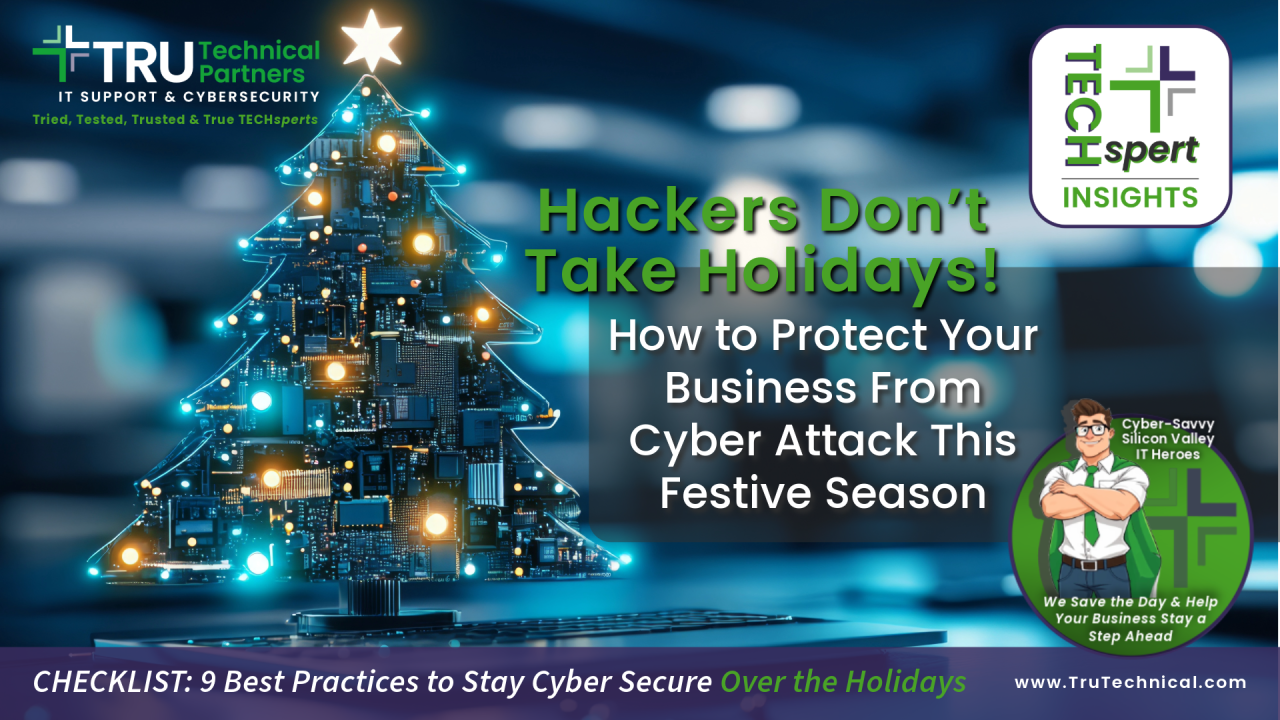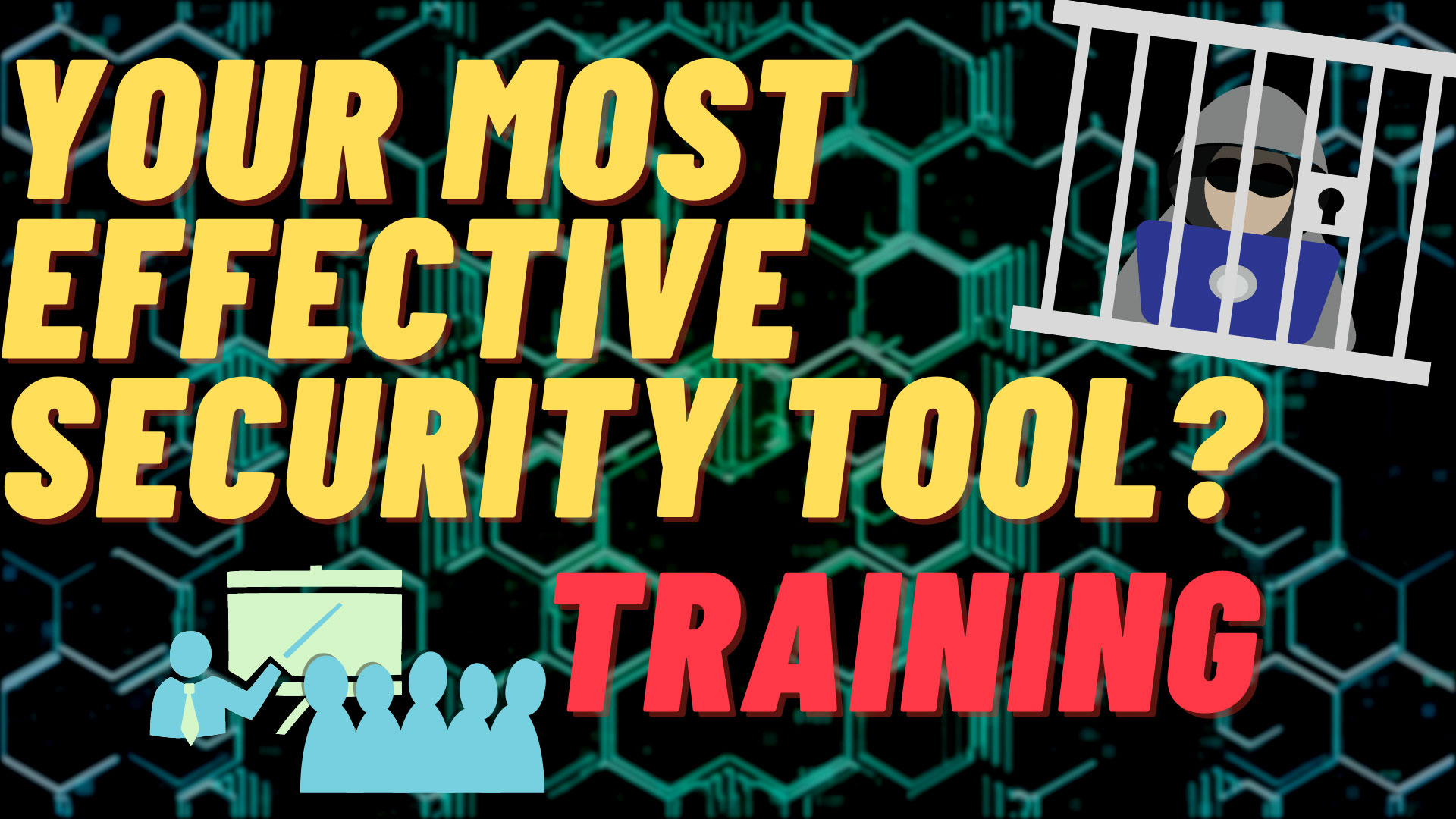Hackers Don’t Take Holidays! How to Protect Your Business From Cyber Attack This Festive Season
Cybercriminals are well aware that many businesses operate with reduced staffing levels during the holidays, leaving them more vulnerable to threats. Small and medium-sized business owners should be especially vigilant against the surge in cyberattacks that often occurs during this festive time.
In this TECHsperts Insights Guide we’ll look at some examples of common cyber crimes committed during this period. Plus, we suggest nine best practices you should deploy as part of your end-of-year tech strategy.
“Every year, thousands of people become victims of holiday scams. Scammers can rob you of hard-earned money, personal information, and, at the very least, a festive mood.”
‘Common Frauds and Scams: Holiday Scams’ — www.fbi.gov
While the end of the year should be an opportunity for you to kick back and relax, it's unfortunately also a time when hackers are more active than ever: with people shopping online, traveling, and using public Wi-Fi more frequently, there are ample opportunities for these bad actors to steal sensitive information.
In general, you need to be on the lookout for the following:
- Phishing scams are prevalent, exploiting the influx of emails and websites offering deals and promotions. Hackers disguise phishing attempts as shipping notifications, e-cards, and fake shopping deals to trick individuals into revealing personal information.
- Ransomware attacks also surge during this period as businesses are occupied with holiday operations, making them more vulnerable. Cybercriminals exploit known system vulnerabilities, especially when IT teams are short-staffed.
- Business email compromise (BEC) scams pose another significant threat, targeting businesses with fraudulent invoices and payment requests amidst the holiday rush.
Be aware of these specific holiday hacking examples:
One alarming tactic is the 'Evil Twin' attack, where hackers set up rogue Wi-Fi networks that mimic legitimate ones, tricking unsuspecting employees into connecting and exposing sensitive data. This kind of attack can easily occur in public spaces where employees might be working remotely, taking breaks — or traveling to a holiday destination.
Other prevalent holiday-period cyber dangers include online shopping scams such as non-delivery (where goods are paid for via online transactions, but the items are never received), and non-payment (where goods or services purchased through online transactions are shipped, but payment is never received for them). Other digital scams include online auction fraud (where sites misrepresent items purchased on auction), and gift card fraud (when a buyer is invited to pay with a pre-paid ‘gift’ card).
Also important to consider is the seemingly innocuous act of setting an 'Out of Office' email reply, which can inadvertently invite trouble. While it informs clients, employees, colleagues and partners of your absence, it also signals to cybercriminals that your defenses are down.
Automated replies can be exploited to launch targeted phishing attacks, as attackers may use this information to craft messages that appear legitimate.
Overall, to secure work environments during the holidays — especially when remote work is being done — businesses should, at the very least, implement these three crucial steps:
- Enforce the use of corporate VPNs: A VPN encrypts internet traffic and protects privacy, which is essential when employees use public Wi-Fi while traveling or working remotely.
- Mandate encryption for all devices: Encrypting all devices used for work purposes helps safeguard sensitive information from unauthorized access, especially if a device is lost or stolen.
- Prohibit the use of public Wi-Fi for sensitive work: Public Wi-Fi networks are often unsecured, making them prime targets for cybercriminals seeking to intercept data. Encourage employees to use secure networks or mobile hotspots for work-related activities.
As a business owner, understanding these kinds of risks is crucial to safeguarding your company’s data and reputation during the holiday season.
Here are nine more detailed best practices that will help you and your business stay safe online during the holidays:
1. Employee Training and Awareness
- Conduct regular cybersecurity awareness training sessions, specifically highlighting holiday-specific threats like phishing emails disguised as shipping notifications, e-card scams, and fake holiday shopping deals.
- Train employees to be extra vigilant about unsolicited emails, suspicious links, and unexpected attachments during this high-risk period.
- Empower employees to verify unusual requests, such as changes in payment details or wire transfers, to prevent falling victim to cyberattacks.
- Educate employees on how to recognize phishing attempts and suspicious links to prevent initial access points for ransomware.
2. System and Software Security
- Ensure all devices, software, and systems are running the latest security updates. Cybercriminals often exploit known vulnerabilities, especially during busy holiday periods when IT teams might be short-staffed. Set up automatic updates where possible and conduct a comprehensive system review before the holiday season begins.
- Regularly update all operating systems, applications, and security software. Regular updates patch vulnerabilities that could be exploited by ransomware.
3.Strong Authentication and Access Control
- Require multi-factor authentication for all business and personal accounts. This adds an extra layer of security beyond passwords, making it significantly harder for unauthorized users to access sensitive information. Use authenticator apps or hardware tokens instead of SMS-based authentication for enhanced protection.
- Review and restrict administrative and high-level system access. Implement the principle of least privilege, ensuring employees only have access to the systems and data necessary for their work. Create a detailed access log and monitor for any unusual activities, especially during the holiday season when typical work patterns change.
4. Secure Remote Work Practices
- With many employees working remotely or traveling during the holidays, ensure secure connections through:
- Enforce strong security protocols, such as using VPNs and ensuring secure access methods, to protect company data from potential breaches if employees work remotely.
5. Data Protection and Backups
- Create comprehensive, encrypted backups of all critical business and personal data. Store backups in multiple locations, including offline and cloud-based storage. Test your backup and recovery processes to ensure you can quickly restore systems if a cyberattack occurs.
- Encrypt sensitive customer information both in transit and at rest. Ensure compliance with data protection regulations (e.g., GDPR, CCPA) to safeguard customer trust during increased transactions.
- Back up critical data regularly and follow the 3-2-1 backup rule (three copies of data, two different media types, one offsite). This ensures that you can restore your data without paying a ransom if an attack occurs.
6. Proactive Security Measures
- Implement robust endpoint protection solutions that go beyond traditional antivirus software. Look for tools with:
- Set up monitoring tools to detect suspicious activities within your network. Utilize Security Information and Event Management (SIEM) software for real-time anomaly detection and response.
- Implement network segmentation to limit the spread of ransomware within your organization. By isolating critical systems from less secure areas, you can contain potential breaches more effectively.
- Invest in security monitoring solutions to detect unusual activities within your network. This proactive approach can help identify threats before they escalate into full-blown attacks.
- Perform thorough risk assessments to identify vulnerabilities within your systems and processes. Addressing these weaknesses can significantly reduce the chances of a successful attack.
- Perform a thorough assessment of your cybersecurity measures before the holiday season begins. Identify vulnerabilities through penetration testing and vulnerability scans to address weaknesses proactively.
7. Vendor and Supply Chain Security
- Scrutinize all communications from third-party vendors during the holiday rush to avoid business email compromise scams. Verify invoices and payment requests to ensure their legitimacy.
- Ensure that all third-party vendors follow strong cybersecurity practices. Supply chain vulnerabilities can lead to ransomware attacks, so verify their security measures before engaging with them.
8. Incident Response Planning
- Create a comprehensive incident response plan specifically tailored to holiday-season cyber risks. This plan should include:
- Create a well-defined plan detailing how to respond to cyber incidents. Ensure that all team members know their roles in the event of a breach, which can minimize damage and downtime during critical periods.
- Create a comprehensive incident response plan that outlines steps to take in the event of a ransomware attack. This should include identifying the attack's extent, isolating affected systems, and communicating with stakeholders.
- Regularly conduct tabletop exercises or simulations to test your incident response plan. This practice helps ensure that your team is prepared and knows their roles during an actual attack.
9. Additional Considerations
- Divide your network into separate segments to limit potential breach impacts. Adopt a zero-trust security model that requires verification for every access attempt, regardless of whether it originates from inside or outside your network. This approach significantly reduces the potential damage from a successful cyberattack.
- Consider purchasing cyber insurance that covers holiday-season specific risks and provides support in case of a significant security breach.
By implementing these best practices, you can significantly reduce your vulnerability to cyberattacks during the holiday season, protecting both your business and personal digital assets.
Access our free resources to learn how to protect your business effectively
Keep this vital advice handy by downloading our convenient Holiday Season IT Protection Cybersecurity Checklist so you can ensure an enjoyable holiday break, knowing that your data and your business’s precious resources are secure.
Our TECHsperts Insights ‘TRUTALK: Technically Speaking’ podcast also gives you a convenient way to learn on the go about securing your data from bad actors at this especially risky time of year. You can listen to the 20-minute deep dive on the topic here.
We know all about the types of dangers out there. We’ve been helping to keep businesses safe in the Bay Area, Silicon Valley and beyond for the past 30 years, so you can trust that we have your back.
How vulnerable is your organization? Take our Cyber Threat Quiz to find out, or contact us if you have any other questions.
Stay safe! Be hypervigilant against increased cyber threats this Christmas season. Wishing you Happy Holidays from the Tru Technical Team!
Save time by accessing your Android phone’s files with File Explorer
Microsoft is working on an update that will allow Windows 11 File Explorer to directly access files on your Android phone, making file transfers smoother and faster than ever before.
Why’s this is such a big deal and how it can boost productivity for you and your team?
Imagine you’re in a meeting and need to quickly pull up a document or photo from your phone. Normally, you’d have to email it to yourself or transfer it using a cloud service. This can be time-consuming and cumbersome.
With the upcoming Windows 11 update, you’ll be able to access your Android phone’s files directly through File Explorer. No more fumbling with multiple steps, just quick, easy access to what you need.
This feature isn’t just about increased convenience; it’s a big productivity booster. By streamlining the process of transferring files between your phone and computer, you can save time. When you’re busy, every minute counts, and fewer interruptions make a smoother workflow.
Your team will also benefit from this update. This can lead to better collaboration and faster decision-making.
From a technical standpoint, this feature is designed to be user-friendly. There’s no need for complicated setups or third-party apps. It will be built right into the Windows 11 operating system, so once the update is rolled out, you’ll have everything you need at your fingertips. It lets everyone on your team take advantage of the new functionality without needing training or support.
Of course, we must mention another important aspect to consider: Security.
Microsoft is known for its robust security measures, and this new feature is no exception. Your data will be protected throughout the transfer process, giving you peace of mind that sensitive information remains secure.
Sounds good, doesn’t it?
We don’t have a release date yet. But if you want more help with productivity tools to make your business more profitable, we can help. Get in touch.
Are You Aware of the Digital Risks to Your Business?
Rapid technological advancement and rising global connectivity are reshaping the way the world is functioning. From higher productivity to improved customer satisfaction, technology has played a critical role in the growth of businesses across the world. However, the consequential bad news is that technological advancements have also made organizations increasingly vulnerable to digital risks. However, this does not mean that businesses must compromise on growth and advancement for the sake of security.
Organizations that understand how to detect threats and include preventative security measures and controls, as well as proactive solutions and thorough strategies, may better meet the security problems they face in modern digital environments. Let’s discuss the different types of digital risks you should be looking out for and how you can use this information to get positive ROI.
Types of digital risks
Digital risks are increasing in the business world due to the rapid adoption of new disruptive technologies. These risks are seen in various industries and are more pervasive than cybersecurity risks. On a broader scale, digital risks can be classified into physical, technical and administrative risks.
The following risks are the most prevalent in today’s digital world and should be treated as top priorities to mitigate for your business:
- Cybersecurity risk: Cyberattacks continue to evolve as businesses become more technology driven. Attacks like ransomware, DDoS, etc., can disrupt the normalcy of any business.
- Data privacy risk: As we move forward to a knowledge-based economy, data has become the most valuable commodity in the world. This has resulted in hackers targeting critical business data and misusing it for personal gain.
- Compliance risk: Businesses need to adhere to various regulations regarding data privacy, cybersecurity, organizational standards of practice, etc. Any violation can attract heavy fines and penalties for a business.
- Third-party risk: When you outsource certain services to third parties, it might compromise the security of your IT infrastructure. For instance, a software tool you develop with an external vendor may introduce some vulnerabilities to your otherwise intact digital environment.
- Resiliency risk: This concerns the ability of a business to bounce back and continue operations after an unexpected disaster.
- Risks due to human errors: In 2021, 85% of data breaches involved some human element.* Whether it’s falling for phishing scams, credential stuffing or misusing work devices, human errors can be quite costly for organizations if they go unchecked.
- Automation risks: While automation is reshaping the tech industry for the better, it could also give rise to a range of risks such as compatibility risks, governance risks and more.
- Cloud storage risks: The flexibility, ease of use and affordability offered by the cloud make it one of the most popular options for backup and storage. However, the cloud is also prone to various risks such as lack of control over data, data leakage, data privacy, shared servers and more.
Why risk assessment is critical in managing digital risks
The best way to start managing your digital risks is by performing comprehensive security risk assessments regularly. After all, how would you know what your current vulnerabilities or gaps are and where your biggest security challenges lie without an “under the skin” examination?
With a risk assessment, you can measure your security posture against various internal and digital threats and determine how equipped you are to deal with these risks. When you perform a security risk assessment you can proactively:
- Identify vulnerabilities: A risk assessment helps you identify which part of your digital environment is relatively weak against various security threats. You can identify which systems are likely to be targeted by attackers and incorporate measures to strengthen these systems. Without the information presented by your risk assessment report, you don’t stand much chance of improving your digital security posture against various vulnerabilities.
- Review and bolster security controls: In most cases, security incidents occur due to a lack of controls in the process. For instance, without proper cybersecurity awareness training and best practices training, employees are unlikely to follow security protocols on their own, which could result in losses due to human errors. Based on the risk assessment, you can upgrade your securities and incorporate preventive measures against various risks.
- Track and quantify risks: To effectively manage various risks, you need to know their effect on your business. With a risk assessment, you can quantify these risks by identifying the potential losses posed by various threats. This helps you incorporate necessary risk-mitigation strategies to prevent exposure.
The value of risk assessment
IT and security budgets are often difficult to explain to management. Everyone understands the consequences of not investing in the correct security measures. However, it isn’t that easy or simple to put an exact ROI figure on security investments. The value of risk assessment is based on how you choose to act with the information you get from these reports.
In this scenario, the real question is – what is the cost of not making this investment? Let us consider a major data breach for example. It is always about what you stand to lose in the aftermath of a breach. If your business is dealing with valuable customer data, a data breach can result in unrecoverable financial losses as well as reputational damage. Moreover, this might also result in regulatory non-compliance and attract heavy penalties from various regulators. In such cases, reviving a business after a major disaster can be almost impossible.
Here, the cost of investment in security solutions and cyber insurance is negligible since it concerns the survival of the business. You may not be able to measure the exact ROI of the airbags in your car but that does not mean that your survival is not dependent on them. Similarly, the information and insights gained from routine risk analyses are critical to the operation, resilience posture and long-term success of your business.
Assess your risks the right way
Monitoring and managing your digital security risks is a continuous process that must be done regularly and should be a part of your ongoing operational strategy.
Contact us today to perform a complete risk assessment of your digital infrastructure to help you build a resilient security posture against various threats.
*2021 Data Breach Investigations Report
Human Error: The Biggest Cybersecurity Risk for Small and Medium-sized Businesses
Effective Cyber Security Training by Tru Technical Partners
Small and medium-sized businesses (SMBs) face a growing number of cyber threats. While technological advancements have provided numerous benefits, they have also introduced new vulnerabilities. Among these vulnerabilities, human error stands out as the most significant cybersecurity risk faced by SMBs. Our goal is to shed light on the importance of cyber security awareness training and provides insights on how businesses can mitigate this risk effectively. Our Guide Book: Cyber Security Awareness Training will help you with the following:
Understanding Human Error as a Cybersecurity Risk: Human error refers to unintentional actions or mistakes made by individuals that can lead to security breaches and cyber attacks. In the context of cybersecurity, these errors often arise due to a lack of awareness, negligence, or inadequate training. Common examples of human error include falling victim to phishing scams, using weak passwords, failing to apply software updates, or improperly handling sensitive data.
Assessing Your Baseline Security Knowledge: Before implementing a cybersecurity training plan, it is crucial to evaluate the baseline level of security knowledge within your organization. This assessment will help identify areas where employees may be particularly vulnerable to making mistakes or lacking awareness. Conducting surveys or interviews, analyzing past incidents, and reviewing security policies are effective ways to gauge your current security knowledge baseline.
Identifying the Biggest Risks to Your Business: Each business faces unique cyber threats based on its industry, size, and operational practices. Identifying the specific risks your business is most susceptible to is essential for developing targeted training programs. Common risks for SMBs include phishing attacks, social engineering, ransomware, data breaches, and insider threats. Conduct a thorough risk assessment to understand the potential impact and likelihood of each risk and prioritize accordingly.
Creating a Comprehensive Training Plan: A well-designed training plan is crucial for equipping employees with the necessary knowledge and skills to mitigate cyber risks. Here are key steps to consider when creating your training plan:
- Define objectives: Clearly outline the desired outcomes of the training program, such as reducing phishing susceptibility or promoting data protection best practices.
- Tailor content: Develop training materials that are relevant to your business and industry. Focus on practical examples and real-life scenarios to enhance engagement and understanding.
- Delivery methods: Consider a combination of interactive workshops, online modules, simulated phishing exercises, and periodic reminders to reinforce learning.
- Ongoing education: Cybersecurity threats evolve rapidly, so continuous education is vital. Establish a culture of learning and provide regular updates on emerging threats and best practices.
- Engage leadership: Leadership support and involvement are crucial for fostering a security-conscious culture. Encourage executives to participate in training sessions and set a positive example for employees.
Human error poses a significant cybersecurity risk for SMBs. Recognizing the importance of cyber security awareness training and implementing a comprehensive training plan is essential for mitigating this risk. By continuously educating employees, tailoring training to address specific vulnerabilities, and measuring the effectiveness of the program, businesses can empower their workforce to become the first line of defense against cyber threats. Download our free guide for more in-depth insights and guidance on building a robust cybersecurity strategy.




